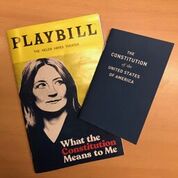Ordinarily, each of our blog posts focuses on a single issue that constitutes (ahem!) a fault line in the Constitution. For instance, in November 2017, we discussed political problems that could arise if the plague comes to America. And, recently, we explained how the House of Representatives could end up picking the next president. This post is different, partly because we address several issues rather than just one. In addition, the co-authors of the book—Cynthia and Sanford Levinson—star in this post along with several real Broadway stars.
 First, some background. An actress and playwright named Heidi Schreck developed a play called What the Constitution Means to Me. The play is based on competitions Heidi entered at American Legion posts when she was a teenager. She won enough of them to pay her way through college! (These Oratorical Contests still exist.) As a teen, she compared the US Constitution to a crucible or a cauldron, in which a lot of ideas about how to run the country came together in Philadelphia in 1787 and were forged into our system of government. As an adult, she began to realize that the Constitution has flaws, particularly in regard to its failure to protect vulnerable groups, including women, blacks, and gay people. Furthermore, she is now aware—and wants us to be aware as well—that many countries’ constitutions address what are called positive rights, such as the right to health care or housing. The American constitution she was told, on the other hand, focuses on negative rights, which limit the government from intruding into citizens’ lives.
First, some background. An actress and playwright named Heidi Schreck developed a play called What the Constitution Means to Me. The play is based on competitions Heidi entered at American Legion posts when she was a teenager. She won enough of them to pay her way through college! (These Oratorical Contests still exist.) As a teen, she compared the US Constitution to a crucible or a cauldron, in which a lot of ideas about how to run the country came together in Philadelphia in 1787 and were forged into our system of government. As an adult, she began to realize that the Constitution has flaws, particularly in regard to its failure to protect vulnerable groups, including women, blacks, and gay people. Furthermore, she is now aware—and wants us to be aware as well—that many countries’ constitutions address what are called positive rights, such as the right to health care or housing. The American constitution she was told, on the other hand, focuses on negative rights, which limit the government from intruding into citizens’ lives.
After explaining this—in a much more humorous and moving way than we’ve done here—Heidi and a New York City high school student hold a debate. The topic is “Resolved: The US Constitution Should Be Abolished.”
 Here’s where we come in. To write that part of the play and to prepare for the debate, Heidi drew on our book, Fault Lines in the Constitution. In fact, she has written, “This provocative and fascinating book brought the Constitution to life for me and made me question my deepest assumptions about our country…I wish every student in America would read it.” (So do we!) As a result, she asked us to do a talkback—that is, talk about our book and the play—after the performance on May 8, 2019. Here we are, onstage, with Thursday Williams, one of the two students who trade off in the role.
Here’s where we come in. To write that part of the play and to prepare for the debate, Heidi drew on our book, Fault Lines in the Constitution. In fact, she has written, “This provocative and fascinating book brought the Constitution to life for me and made me question my deepest assumptions about our country…I wish every student in America would read it.” (So do we!) As a result, she asked us to do a talkback—that is, talk about our book and the play—after the performance on May 8, 2019. Here we are, onstage, with Thursday Williams, one of the two students who trade off in the role.
Unlike us, Thursday is a fan of the US Constitution. Like Heidi when she was a teenager, she believes that the Framers did the best they could and that the compromises they made were necessary to create a workable government. Actually, we don’t disagree with her. If they hadn’t made certain compromises, the United States of America might well not exist; there might be two or three countries here instead, as we explain in the book.
Where we disagree is over how well the government works now and whether it needs a do-over. We pointed out, for example, that it might have been necessary in 1787 for the Constitution to give every state two senators, regardless of the size of its population. Today, however, most people in the country live in just several states. As a result, less than half the population sends eighty-two senators to Congress while the other more-than-half are represented by only eighteen senators. We discuss this problem in Chapter 2 in the book.
As you might be able to tell, our book focuses on the structures of our government, such as the composition of the Senate and how members of the House of Representatives are elected. Heidi’s play, on the other hand, focuses on rights. We think the book and the play complement each other well!
There are several ways in which the book and the play are similar. We all address the issue of why the Equal Rights Amendment was never added to the Constitution. The answer, which we write about, is that the document gives a bigger advantage to those who want to keep it than to those who want to change it. Heidi despairs because the Constitution continues to fail to recognize women. We despair because the Constitution is so difficult to amend.
Both the play and the book raise other issues as well. What the Constitution Means to Me discusses the Ninth and Fourteenth Amendments, including the Due Process clause and the Equal Protection clause. The updated edition of Fault Lines in the Constitution, published in August 2019, examines twenty problems with the Constitution. Together, we cover a lot of topics—both some of the basic rights that are not designated and many of the structural flaws in our government today.

Another similarity is that the co-authors and the playwright tell stories. Heidi talks about her great-great-grandmother, her mother, and her aunt—all women who needed protection from men in their lives and did not receive it. We open every chapter with a story that illuminates a fault line. For instance, Chapter 4 on “Supermajority Rules” describes the dilemma of a Dreamer who has been unable to become a US citizen. Both the play and our book show how the Constitution affects not only politics but also our personal lives today.
We are grateful to Heidi Schreck and to the cast and crew of What the Constitution Means to Me for finding our book so helpful and for inviting us to appear on a Broadway stage! The play was a finalist for the Pulitzer Prize and has been nominated for two Tony Awards—Best Actress and Best Play. We will be cheering them on when the awards are announced on June 9, 2019. Above all, we are pleased that so many people are thinking, writing, talking—and acting—about our Constitution and its flaws.

Did you hear of the Swiss watches ?? This site is a collection of watch brands from all over the world. A luxury watch gives you wireless confidence.
LikeLike
The play is brilliant- go when it comes to your city on tour! Some cities are already announced. It is such a phenomenal companion for the Levinson’s brilliant book! http://www.playbill.com/article/what-the-constitution-means-to-me-to-launch-national-tour
LikeLike